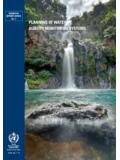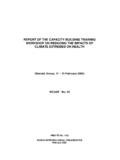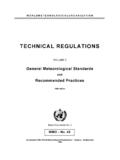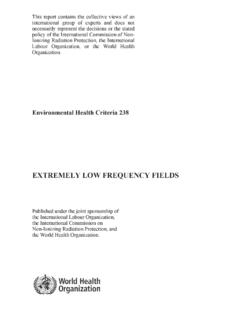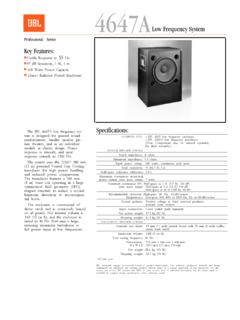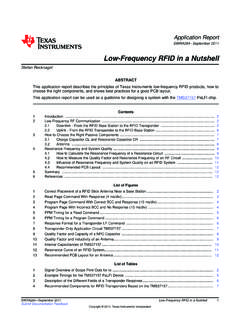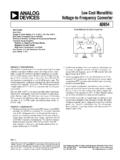Transcription of Manual on Low-flow - wmo.int
1 World Meteorological Organization7 bis, avenue de la Paix Box 2300 CH-1211 Geneva 2 SwitzerlandTel. : +41 (0) 22 730 81 11 Fax: +41 (0) 22 730 81 81E-mail: wmo @ Website: 1029 OPEraTiONal HydrOlOGy rEPOrT No. 50 Manual ON Low-flow ESTiMaTiON aNd PrEdiCTiONManual on Low-flow Estimation and PredictionOperational Hydrology report No. 50 Manual on Low-flowEstimation and PredictionOperational Hydrology Report No. 50 WMO-No. 1029 WMO-No. 1029 World Meteorological Organization, 2008 The right of publication in print, electronic and any other form and in any language is reserved by WMO. Short extracts from WMO publications may be reproduced without authorization, provided that the complete source is clearly indicated.
2 Editorial correspondence and requests to publish, reproduce or translate this publication in part or in whole should be addressed to:Chairperson, Publications BoardWorld Meteorological Organization (WMO)7 bis, avenue de la Box No. 2300CH-1211 Geneva 2, Switzerland Tel.: +41 (0) 22 730 84 03 Fax: +41 (0) 22 730 80 40E-mail: 978-92-63-11029-9 Cover photograph: M. HallLayout:IHP/HWRP Secretariat Federal Institute of HydrologyAm Mainzer Tor 156068 Koblenz GermanyTel.: +49 (0) 261 / 13 06 - 5435 Fax: +49 (0) 261 / 13 06 - 5422 National Committee for the International Hydrological Programme (IHP) of UNESCO and the Hydrology and Water Resources Programme (HWRP) of WMOK oblenz 2009 Scientific Editors:Alan Gustard and Siegfried DemuthLinguistic Editor:Susan ParkerBfG Federal Institute of HydrologyGerman IHP/HWRP National CommitteeNOTE.
3 The designations employed in WMO publications and the presentation of material in this publication do not imply the expression of any opinion whatsoever on the part of the Secreta-riat of WMO concerning the legal status of any country, territory, city or area, or of its authorities, or concerning the delimitation of its frontiers or expressed in WMO publications are those of the au-thors and do not necessarily reflect those of WMO. The mention of specific companies or products does not imply that they are endorsed or recommended by WMO in preference to others of a similar nature which are not mentioned or VPreface VIIA cknowledgement VIIIList of Authors IXSummary X1. Introduction 13 Objectives 13 Background 13 Manual structure 14 Methodologies not included in the Manual 15 Guidelines for national practices 152.
4 Estimating, Predicting and Forecasting Low Flows 16 Introduction 16 Low-flow information 16 Design issues 17 Previous studies 20 Dissemination of results 20 Key principles in Low-flow design 203. Hydrological Data 22 Introduction 22 Data for Low-flow analysis 22 Preparation of good-quality data for Low-flow analysis 264. Processes and Regimes 36 Introduction 36 Processes causing low flows 36 Low flows in different hydrological regimes 395. Low-flow indices 43 Introduction 43 Base-flow index 43 Recession analysis 44 Low-flow statistics 47 Operational applications 486. The Flow-Duration curve 50 Definition and derivation 50 Standardization 51 Durations and seasons 52 Percentiles as Low-flow indices 53 Applications of the FDC 537.
5 Extreme value analysis 57 Introduction 57 Example data for at-site Low-flow frequency analysis 57 Introduction to frequency analysis 58 Extreme value selection 60 Distribution functions 61 Parameter estimation methods 63 Estimation of the T-year event 64 Application of the Weibull distribution for Low-flow frequency analysis 65 Regional frequency analysis 67 IVContents8. Streamflow deficit 71 Introduction 71 Definition and derivation 71 Application: Determination of streamflow deficit characteristics 73 Definitions of Low-flow and deficit characteristics: National standards in Germany 749. Estimating low flows at ungauged sites 77 Introduction 77 Empirical methods 77 Statistical methods regionalization 78 Catchment modelling 81 Use of local data 8410.
6 Estimating low flows in artificially influenced rivers 88 Introduction 88 Inventory of artificial influences 88 Artificial influences 89 Estimating artificially influenced low flows 92 Flow naturalization 94 Climate and land-use change 9511. Low-flow forecasting 98 Introduction 98 Short-term forecasting 99 Medium-term forecasting 101 Purpose of long-term forecasting 102 Basic modelling techniques for forecasting 104 Conclusions 10712. Case studies 108 Summary of the case studies 108 Transboundary rivers 109 Catchment-based water resources decision-support tool in the United Kingdom 115 Low-flow management issues in the United Kingdom 117 Real-time management of environmental flow requirements for the Thukela River in South Africa 120 Regionalized resources models for small-scale hydropower: India and Nepal 123 Residual flow estimation and hydropower: Norway 12513.
7 Recommendations and conclusions 129 Introduction 129 Operational applications 129 Capacity-building 131 Abbreviations 134 Operational Hydrology Reports 136 VFoReWoRDForewordThe Commission for Hydrology (CHy) decided at its twelfth session (Geneva, October 2004) to prepare a Manual on Low-flow estimation and prediction to meet the identified needs of National Hydrological Services. The Manual on Low-flow Estimation and Prediction, which consists of 13 chapters, was drafted by the Open Panel of CHy Experts (OPACHE) on Disaster Mitigation Floods and Droughts (Hydrological Aspects). The list of authors is provided on page drafting team was initially led by Mr Siegfried Demuth (Germany), then by Mr Bruce Stewart (Aus-tralia), who also took part in the review process.
8 Mr Charles Pearson (New Zealand) and Mr Syed Moin (Canada) were the Manual s objective is to publish state-of-the-art analytical procedures for estimating and predicting low river flows at all sites, regardless of the availability of observational data. The Manual will be useful for many applications, including water resources planning, efflu-ent dilution estimates and water resources management during Low-flow is a great pleasure to express WMO s gratitude to the authors, the reviewers and to the president of CHy, Mr Bruce Stewart, for their efforts during the preparation of the Manual .(M Jarraud)Secretary-GeneralVIIPReFaCePrefa ceMore often than not, the thought of rivers conjures up the image of high water levels and even floods.
9 How-ever, many communities depend on the availability of water through non-regulated river systems for their wa-ter supply. Therefore, periods of low flow are critical for managing their water resources. Similarly, it is the function and role of dams to level out the fluctuations of high and low flows and to provide a balanced water supply to meet demands. Knowledge of Low-flow pe-riods is therefore fundamental for reservoir design and determining factors have an impact on the Low-flow regimes of rivers. Whenever we change our land uses, we change the way in which water interacts with the landscape, and this can affect the water available in rivers, lakes and dams. Most nations are experiencing popula- tion growth, resource depletion and the overextraction of water.
10 Low flows are critical elements in terms of meeting demands for often competing uses and recently, there have been growing concerns over the relationship between water and the environment, and many counties are conducting research into the requirements for, and delivery of, environmental topic of this Manual , namely Low-flow estimation, is thus of paramount importance for the development and implementation of sustainable water resources ma-nagement practices. I highly recommend this Manual and congratulate its contributors on the guidance pro-vided note that the Manual does not have the full geogra-phical coverage that the Commission for Hydrology would like to see in its publications.



